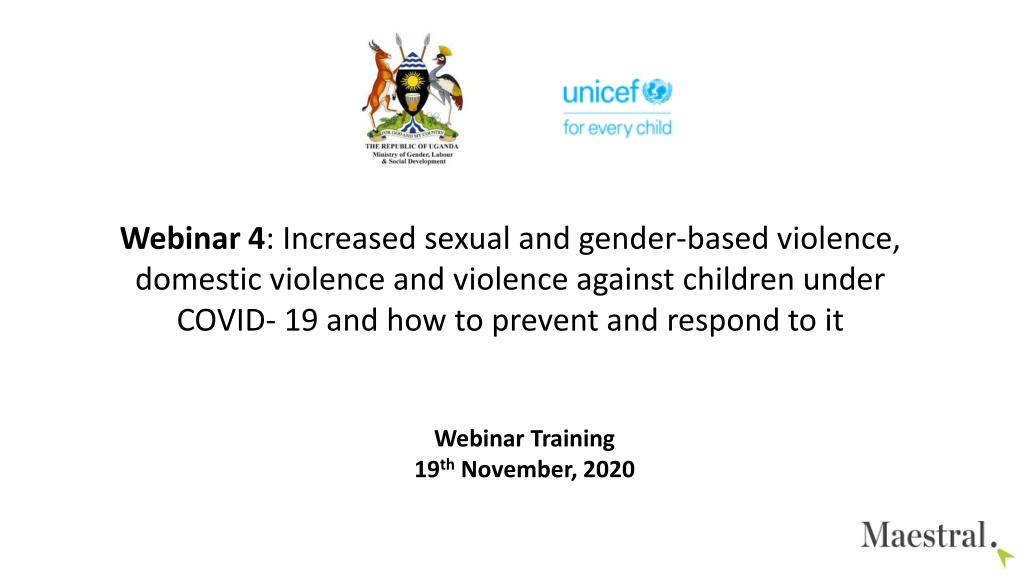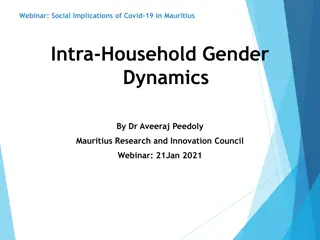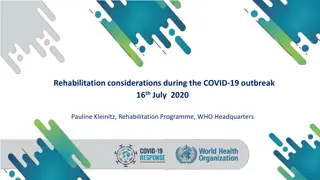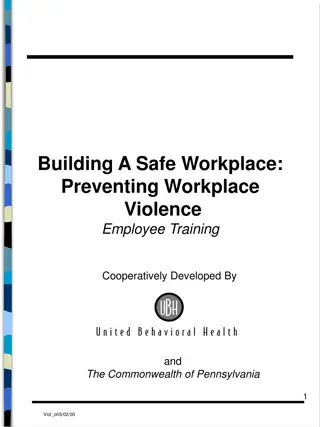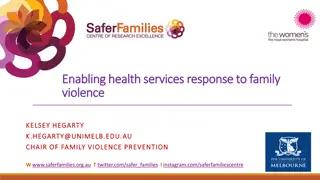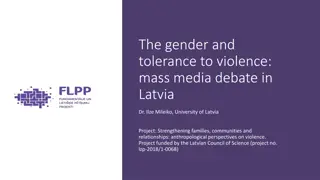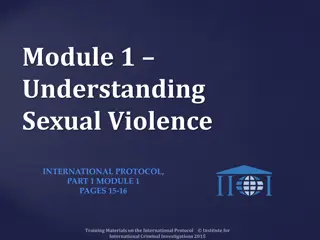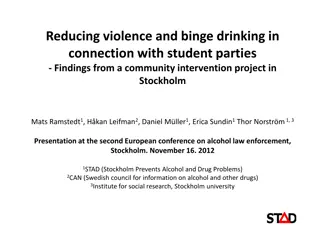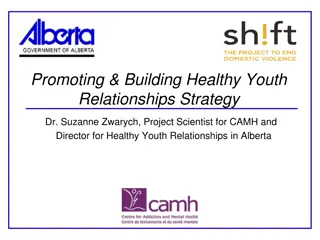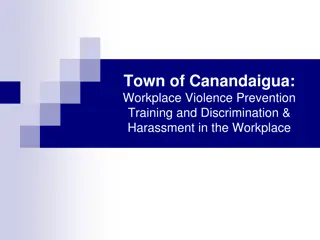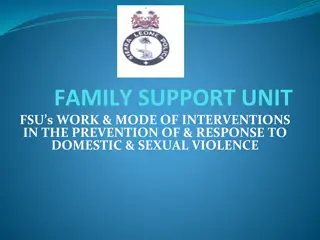Preventing and Responding to Increased Violence During COVID-19
Explore how to prevent and respond to increased sexual and gender-based violence, domestic violence, and violence against children under COVID-19. The webinar on 19th November, 2020 aims to identify risks and actions to combat violence, emphasizing key principles and global guidance. Participants will engage in breakout discussions on effective strategies amidst the pandemic.
Download Presentation

Please find below an Image/Link to download the presentation.
The content on the website is provided AS IS for your information and personal use only. It may not be sold, licensed, or shared on other websites without obtaining consent from the author. Download presentation by click this link. If you encounter any issues during the download, it is possible that the publisher has removed the file from their server.
E N D
Presentation Transcript
Webinar 4: Increased sexual and gender-based violence, domestic violence and violence against children under COVID- 19 and how to prevent and respond to it Webinar Training 19th November, 2020
1. Please keep your cameras off during the presentation section 2. The host will unmute your microphones before you go into breakout rooms so you can speak to each other in the breakout room Before we start 3. During the breakout and afterwards feel free to keep your camera on 4. We will leave time after the webinar for a virtual tea break
Welcome (5 minutes) Core technical topic (35 minutes) A reminder: Structure of the webinars Breakout rooms (10 minutes) Reflection (10 minutes) Post-webinar survey (2 minutes)
Overall aim of this webinar: To identify the potential risks contributing to violence against women and children, including sexual and gender-based violence, in the context of COVID-19, and to explore locally appropriate prevention and response actions Webinar 4: Welcome and introduction Key principles informing the session Useful for here and now but also forward looking Informed by global guidance and child rights instruments Contextualized and fit for purpose (i.e., practical) Strengths- based Participatory
Please write down this question: What can we do to prevent and respond to violence during COVID-19? You will be discussing this later in your breakout groups Breakout time!
Before we begin key messages Violence is never okay! GoU is committed to prevent violence against children (VAC) and women (VAW) and sexual gender-based violence (SGBV). Core function of the social service workforce (SSW): identify, prevent and support anyone at risk of or experiencing violence. The workforce should use the power they hold positively to ensure safety of the survivor, refer & link survivors to services, respect privacy of the survivor and involve them in the helping process, document cases, and prioritize welfare needs of the survivor.
Violence definitions Violence definitions All forms of physical or mental injury or abuse, neglect or negligent treatment, maltreatment and exploitation, including sexual abuse, intentional use of physical force or power, threatened or actual Violence Sexual and gender- based violence Any sexual act that is perpetrated against a person s will and is based on gender norms and unequal power relationships Physical violence, sexual violence, stalking, or psychological harm by a current or former partner or spouse. It is the most common form of violence against women. Intimate partner violence
GBV is a result of an unequal balance of power between women and men, boys, and girls. It cuts across cultures, ethnic groups, socioeconomic statuses, and religions. Power can be negative or positive depending on how the person who wields it uses it. Negative power is the power we exert over others, it is at the root of violence against women and children. Positive power holds the solution to turn the balance. The SSW can transform negative uses of power into positive use to facilitate prevention and effective response to VAC/W by identifying and implementing solutions to prevent violence Relationship between power, gender and violence
The current pandemic has amplified cases of domestic violence against women and children globally and nationally: Increased concerns and reports on GBV have been expressed in many countries like China, France, Spain, Italy and the UK. Domestic abuse killings more than doubled in first month of containment measures in the United Kingdom. Similarly, in Uganda a reported increase on GBV reports 3,280 cases reported to the police between March and April with an additional 283 VAC cases. *When you have the time, watch this 1.30-hour video on increase of VAC/GBV from leading experts https://www.youtube.com/watch?v=X1_zU98xZso&feature=youtu.be VAC/W and GBV in the context of COVID-19
VAC/W and GBV in the context of COVID-19 Calls to the UCHL significantly increased since the implementation of the containment measures, peaking in May with 41,997 calls, an average of 1354 daily calls. Reports on VAC progressively increased since school closure with August seeing a 44% increase in reported VAC cases at UCHL call centre.
Why are levels of violence increasing during COVID-19 ? 1. Economic insecurity and poverty- related stress Pathways can be both direct & indirect, and are likely to interact, reinforcing existing vulnerabilities. 9. Violence perpetrated against health workers & CP staff 2. Quarantines & social isolation 8. Exposure to violence & coercion in response efforts Pathways linking pandemics & GBV and VAC 3. Disaster & conflict- related unrest & instability These pathways will depend on the type of vulnerability and contextual factors, including underlying gender norms and levels of GBV, VAW and VAC 4. Exposure to exploitative relationships due to changing demographics 7. Inability of women to temporarily escape abusive partners 5. Reduced health services availability and access to first responders 6. Virus-specific sources of violence
Chat box Chat box What types of violence are you noticing in your local community and in your work? Who is the violence perpetrated against? Who is the violence perpetrated by? Is it reported? How is it being responded to?
Legal and policy framework The Domestic Violence Act 2010 and its Regulations 2011 The prohibition of Female Genital Mutilation 2010 and Its regulations 2013 The Prevention of Trafficking in Persons Act 2009 The Penal code Act, Cap 120 The Children Act (as amended, 2016) Cap 59 The International Criminal Court Act 2010 Other laws include the land Act, cap 227, the Employment (sexual Harassment regulations 2012 The Government has also developed policies and frameworks to prevent and respond to VAC & GBV these include; The National Child Policy, 2020 and its Implementation Plan, 2020/21-2024/25; The Uganda Gender Policy(2007); The National Action Plan on Women(2008); The National Development Plan(NDP) 2010/11 - 2014/15 ; National Referral Pathway for Prevention and Response to Gender Based Violence Cases in Uganda (2013); National Guidelines on establishment and Management of GBV Shelters in Uganda and The National Action Plan on the United Nations Security Council Resolution 1325, 1820 and Goma Declaration(2008);
Key Messages to the workforce Health workers should screen patients to detect GBV and VAC. Manage physical injuries and offer emergency treatment to victims of violence Support specialized health services, such as post-rape care, and specialized education services, particularly for children who have missed years of school. Managing the underlying psychological and mental health problems/effects of survivors/victims and perpetrators. The education sector should play a critical role in integrating knowledge on VAC/GBV in school programmes and outreaches, discussing cultural norms at schools and with surrounding communities. The education sector should report incidences of violence and provide psychosocial support and counselling to children and families at risk of violence where appropriate. Both health workers and educators should enhance parents knowledge on children s growth and development, managing their bodies, relationships, homes and families.
Key Messages Local leaders should Seek alternative care for children removed from their families of origin and facilitate permanent placement. Local leaders should strengthen district and local level structures and enhance multisectoral services to respond to and prevent violence at home and in schools. The workforce should work together to strengthen positive parenting; educate parents to increase their knowledge and understanding of how their own upbringing influences occurrence of violence against women and children; encourage age specific communication between parents and their children to enhance bonding. Strengthen community networks (protection workforce, family tree (nuclear and extended family), economic strengthening, and advocacy, psychosocial and medical support) through planning, training, and support. Refer parents/guardians for legal support to bring charges against perpetrator
Stay informed and prepared Information Services Coordination Keep updated on local service provision Coordinate with formal and community service providers and networks Keep yourself updated on the latest VAC/W and SGBV information Contacts with health and police Are local GBV services operating and, if so, on a normal schedule? Are there local NGOs conducting violence prevention work? Chiefs and religious institutions Local FM stations and media Police, health, education Act when you suspect or identify VAC/W
Preventing further violence Remember violence is NEVER OK Include VAC and GBV messaging in COVID-19 awareness raising Publicize helplines and hotlines sautichl@gmail.com Remind people of Child Helpline 116; Email sautichl@gmail.com (8am 5pm) MoH: 0800-100-066 0800-203-033 0800-303-033 Free counselling dial *252# (select option 10) Police Emergency hotline: 999/112 0782 909153; 0772 460297; 0772 469 323 Psychosocial support and parenting tips Stress reduction tips Positive parenting Safety planning with vulnerable clients Always check they can talk Help prepare safety plan (details in job aid) Schedule regular calls
Grave concerns on exponential increase in intimate partner violence during COVID-19 Integrate efforts to prevent and respond to all forms of violence against women, children and adolescents into COVID-19 response plans Influence social norms and related behaviors to better safeguard children at home Identify positive and negative coping mechanisms or behaviors that are strengthened and exacerbated by the pandemic (e.g. alcohol use). Step up awareness campaigns, including targeting men at home. Work with community and religious leaders to raise awareness and influence positive behavior through targeted messaging. Advocate for the designation of domestic violence shelters as essential services and increase resources to them and to civil society groups on the front line of response. Special considerations for IPV, VAC & GBV
While COVID-19 infection has lower mortality rate, it is highly contagious and demands higher level of flexibility, and a more layered approach to VAC/GBV case management service delivery than in past epidemics. Case Management, by definition, functions as the central point that links children and families to multiple services. Case management remains a critical service that is possible to continue in most cases with sufficient modification and adaptations to uphold public health guidelines. All duty bearers should: Ensure that all service centers such as GBV shelters have Infection, Prevention and Control (IPC) measures in accordance with standards at all service delivery points. Communicate openly with women and girls about COVID-19 and any changes or potential changes in your methods of service delivery. Case Management Considerations during COVID
Meet with your team to discuss best options for remote support to survivors and remote support to staff. Meet Develop quick and clear new case management protocols with staff incase you move to remote support and consider modalities for remote case management supervision. Develop Case Management Considerations during COVID Strengthen Strengthen staff capacity and confidence to provide remote support. Keep up to date on the latest guidelines from MoH. Follow protocols for infection, prevention and control at each stage and be ready for the situation to change quickly Keep up Ensure Ensure continued safe storage of sensitive documentation Coordinate Coordinate with other services providers. Inform Inform communities that you serve of possible changes ahead of time.
National Referral Networks For effective case management, keep an updated referral network. The referral network consists of partnerships between different sectors, agencies, and government and nongovernmental services that coordinate to provide services, support, and access to justice for victims of violence and their families. A comprehensive and well-publicized referral network helps providers quickly guide children, families to appropriate services and support. *National referral pathways and the roles of duty bearers are discussed in webinar 5 in-depth session on VAC/VAW.
Building back better As containment measures reduce, prioritize visiting households where violence suspected / identified Case management focus on living arrangements to reduce violence e.g. identifying new safe caregivers or social networks Keep violence prevention high on the agenda! Maintain referral networks or coordination that have worked during strict containment measures
Additional reading UNICEF: COVID-19 Protecting Children from Violence, Abuse and Neglect in the Home. https://www.unicef.org/media/68711/file/COVID-19-Protecting-children-from-violence-abuse-and-neglect-in-home- 2020.pdf Inter-Agency Standing Committee, Global Protection Cluster, GBV Prevention and Response: GBV Risk Mitigation and COVID-19 Tip Sheet: https://gbvguidelines.org/wp/wp-content/uploads/2020/04/Interagency-GBV-risk-mitigation- and-Covid-tipsheet.pdf Global Protection Cluster. Identifying & Mitigating Gender-based Violence Risks within the COVID-19 Response. https://gbvguidelines.org/wp/wp-content/uploads/2020/04/Interagency-GBV-risk-mitigation-and-Covid-tipsheet.pdf Always check the Ministry of Health website for latest COVID-19 updates: https://www.health.go.ug/covid/ UNICEF: Protection of Children from Violence in the time of COVID-19. http://www.socialserviceworkforce.org/system/files/resource/files/Protecting-children-from-violence-in-time-of- COVID-English_2020.pdf UNICEF Guidelines to Strengthen the SSW for Child Protection, Feb 2019 https://www.unicef.org/media/53851/file/Guidelines%20to%20strengthen%20social%20service%20for%20child%20 protection%202019.pdf#page=17 INSPIRE Seven Strategies for Ending Violence Against Children. https://www.who.int/publications/i/item/inspire- seven-strategies-for-ending-violence-against-children INSPIRE Handbook, Actions for implementing the seven strategies https://www.who.int/publications/i/item/inspire- handbook-action-for-implementing-the-seven-strategies-for-ending-violence-against-children
Based on what youve learned in this webinar, what can we do to prevent and respond to violence during COVID-19? Breakout time! Nominate one facilitator Nominate one rapporteur You have 10 minutes in your breakout room Provide feedback on the three main points
Thank you! YOU WILL RECEIVE A JOB AID BY EMAIL PLEASE REMEMBER TO COMPLETE THE POLL SEE YOU NEXT WEBINAR!
Tea break! Tea break! The zoom meeting will remain open for 20 minutes for anyone who wants an optional social catch up
